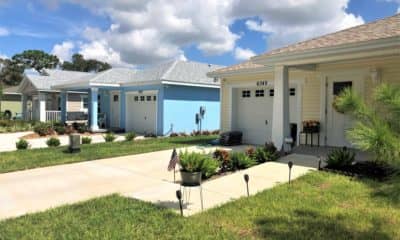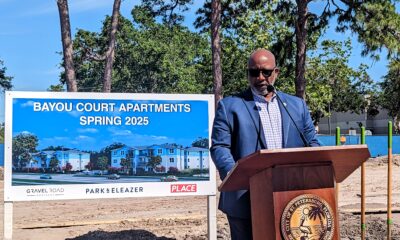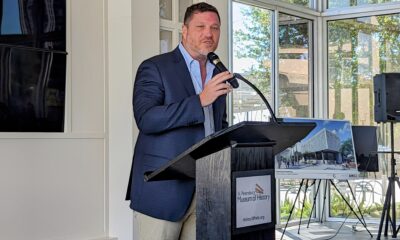Thrive
Does St. Pete have the political will to solve the housing affordability crisis?

The scale of the housing affordability crisis in St. Petersburg and across the country is massive – a crisis by any standard. According to 2017 U.S. Census data, in the City of St. Petersburg alone, 34 percent of homeowners and 52 percent of renters are considered housing burdened, paying more than 30 percent of their income towards their housing. A large majority of those residents are considered “severely” housing burdened, paying 35 percent or more of their income towards housing. And in the two years since those figures were released, unrelenting growth, rising rents and stagnant wages have only intensified the problem.
“Does our community truly have the political will and the long term commitment to address the crisis on the scale that is warranted?” That question was central to the second installment of St. Petersburg City Council Member Brandi Gabbard’s housing affordability community conversations.
Gabbard is no stranger to the housing problem. A real estate broker by trade, Gabbard has made housing affordability one of her trademark issues. Over the summer, she championed a referendum to amend the City Charter to “lockbox” affordable housing funds. However, the original language of the ordinance, which designated funds up to 150 percent of area median income (AMI), was modified in a June 13 meeting by a 5-3 vote to include assistance only up to 120 percent of AMI. Eventually, the referendum was tabled due to disagreement over who the funds should serve, and opposition from Mayor Rick Kriseman’s administration.
In July, Gabbard hosted the first of what she promised would be multiple community conversations around housing. And on Thursday evening, Gabbard kept her promise, bringing together a thoughtfully curated panel discussion featuring housing advocates and experts from numerous agencies and organizations throughout Pinellas County.
“The reason that we all sit here in this room today is because fundamentally, we believe the same thing,” Gabbard said of the panelists. “We believe that everyone deserves a safe, sustainable place to lay their head down at night, regardless of their income or their circumstances. At the end of the day, that is the common thread; how we get there I think we can debate all day long.”
That question of will (or lack thereof), demonstrated by the stalling of the “lockbox” referendum, became a theme throughout the two-hour conversation held at the Sunshine Center, after Gabbard posed the question to housing activist Imam Askia Muhammad Aquil.
“What I don’t see after about 35 years of working in housing … is a comprehensive, multifaceted plan for addressing this that takes all of these various facets and elements into consideration and seeks to scale it up not just on a city, county-wide level but on a regional level,” said Aquil.
“Until we have a comprehensive, multi-faceted plan, I think it’s hard for us to exert the political will – including leadership – because you need leadership to drive this and monitor this. Until we have a plan, we can be concerned and still be frustrated that we’re nibbling around the edges.”
Such a plan is already in the works, according to Whit Blanton, executive director of Forward Pinellas, the county’s land use and transportation planning agency. Still in its infancy, the countywide housing strategy would be an interlocal agreement between all local government entities in Pinellas County. Ideally, the strategy would eventually become regional. The strategy will be modeled after Denver’s Mile High Compact, Blanton said, which addresses critical elements of housing, transportation, land use and water.
“That commitment is absolutely critical,” said Blanton. “One of the big barriers that we continue to have is the stigma and anti-affordability push-back that we get in a lot of communities. We have to look at design, placement, connectivity to overcome some of those community anxieties about what we call ‘affordable housing.’ That’s going to take work and leadership.”
Joe Farrell of the Pinellas Realtors Organization argued that the community must work to incorporate density outside of the downtown core, and urged neighborhoods and specifically neighborhood associations to open up to higher density housing options, which are often more affordable than single family homes, including duplexes and triplexes. He also argued that cities should make housing affordability a higher budget priority.
“If this is as important as we say it is at the local level, we can look at what we have now, and we can reallocate from things that I can tell you that I believe are less important,” said Farrell. “If we say that housing and homelessness are as important as they are, we don’t need to wait for a new tax – Penny for Pinellas is great – but if we really believe this is so important, we can take from what we have now.”
“We don’t have to put $250,000 from our budget toward this when we have a nine-digit budget in most of our municipalities, some approaching the 10th digit,” Farrell explained. “We can put three, four, even five million dollars towards it … We’ve got to get to the user, the consumer homeowner, the person who is renting, they need some bailing out on this too.”
According to Matt Lettelleir, advocacy manager of the St. Petersburg Chamber of Commerce, the success of any of these strategies is contingent on increasing housing stock and moving residents up the “housing ladder” from renting to buying. The Chamber supported Gabbard’s original lockbox idea, supporting residents up to 150 percent of AMI.
“A lot of our workforce that is not from Pinellas … they get an apartment, paying $1,800-$2,000 per month for a single apartment,” Lettelleir explained. “That doesn’t allow many people who are making less than $70,000 a year as a single person to save to have a down payment to get into a house.”
“There’s a lack of housing stock … So if you’re going to have an opportunity for those people get into a house, down payment assistance is the best way to get them out of those apartments – we’re talking the Beacons, Camden Pier District – and get them into houses – and create supply … Now those places are going to open up to the folks living in the Terrier properties paying $800-$1,500 per month, now those prices have dropped and you’ll see more people moving into those properties, and you’ll begin to see people moving up.”








S. Rose Smith-Hayes
October 6, 2019at9:33 am
Canvas for vacant houses, consider purchasing them rehab them and sell them. This problem has been ignored and has gotten worse. 16,000 homeless families and I am sure there are more, is not good. There were 73 homeless families/ living with other people in one of our elementary schools in school year 2018/2019. Two schools have washers and dryers so children can have clean clothes to wear. Several schools serve free breakfast and lunch. The Affordable Housing issue is just one problem crying for attention.Where children live is important to their mental well being as well as their parents. An affordable and decent place to live effects other community issues. Please continue to give this issue serious attention. solicit ideas from the community on a continuous basis.
Dick Schultz
October 5, 2019at2:30 pm
Do we want to become a bankrupt New York City, Chicago, or Los Angles — socialist entities that are taxing their residents into leaving for Texas?
Greg Davidson
October 4, 2019at4:30 pm
I agree with all these comments. It will also help to get a specific dollar amount dedicated from the Penny for Pinellas, and not lump housing in with economic development. There’s also a role foundations can play as another long-term funder of low or no interest rate revolving loans/grants to help lower financing costs.
Karl Nurse
October 4, 2019at4:02 pm
These comments are on the mark. We have to RADICALLY pick up the pace if we are ever going to have an improving situation. There is no magic bullet but we know several things that have to happen: 1) significantly increase capital funding for non-profits to build the entry level houses, 2) change zoning to allow 2,3, and 4 units buildings on lots NOT in the flood zone, 3) increase the speed to process plans and permits (which will take additional staffing), 4) use more carrots (density, fee rebates, etc) and sticks (fees, inclusionary zoning, etc) to be sure that we build a wide spectrum of housing 5) move to a progressive fee structure by reducing base fees and increasing square footage fees and 6) get going to build a real urban transit system (which requires the courage to tell people this will cost money).
Kelly McCarthy
October 4, 2019at3:49 pm
DeSantis and Scott have swept Sadowski fund to their benefit. Using housing funds for vacations that are personal in nature but want us to believe they are business. To afford a more lavish work environment also! It’s wrong and it’s corrupt. Educating the people of Florida is key so we do not vote them in again!